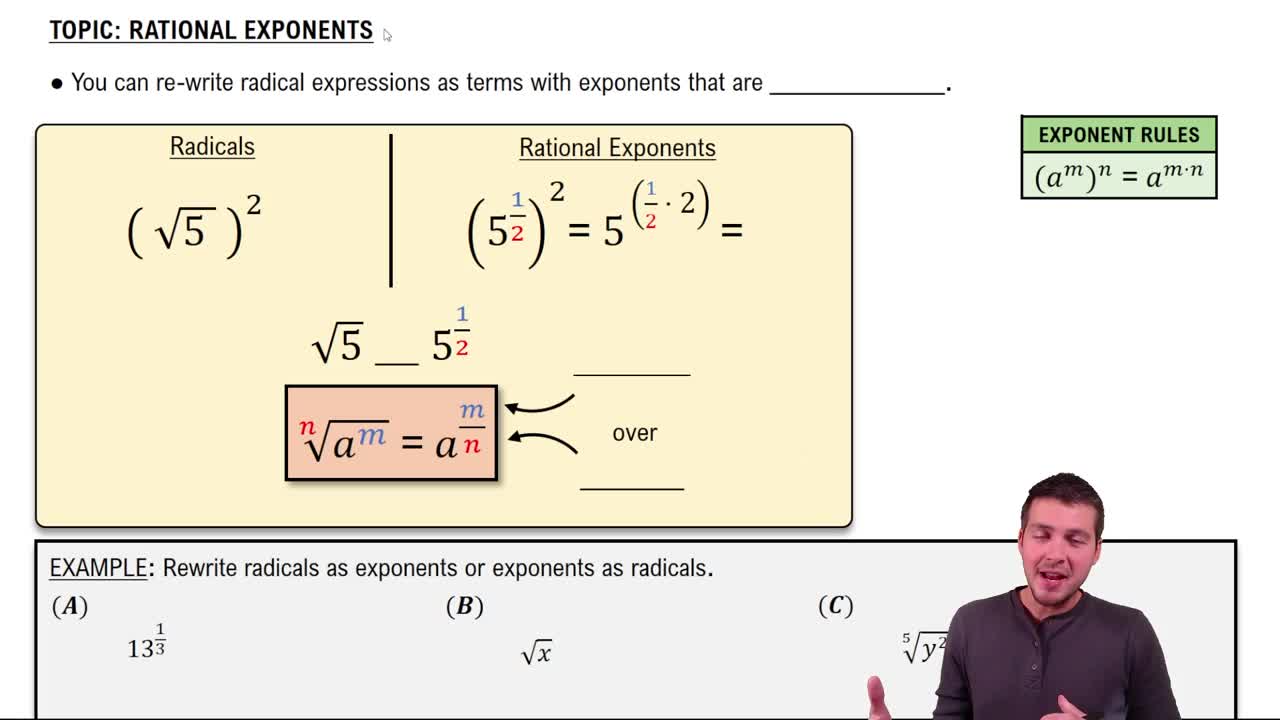Table of contents
- 0. Review of Algebra4h 16m
- 1. Equations & Inequalities3h 18m
- 2. Graphs of Equations43m
- 3. Functions2h 17m
- 4. Polynomial Functions1h 44m
- 5. Rational Functions1h 23m
- 6. Exponential & Logarithmic Functions2h 28m
- 7. Systems of Equations & Matrices4h 6m
- 8. Conic Sections2h 23m
- 9. Sequences, Series, & Induction1h 19m
- 10. Combinatorics & Probability1h 45m
0. Review of Algebra
Rational Exponents
Problem 102
Textbook Question
Simplify each expression. Write answers without negative exponents. Assume all vari-ables represent positive real numbers. See Examples 8 and 9. (p^3)^1/4/(p^5/4)^2
 Verified step by step guidance
Verified step by step guidance1
Start by simplifying the expression \((p^3)^{1/4}\). Use the power of a power property \((a^m)^n = a^{m \cdot n}\) to rewrite it as \(p^{3 \cdot \frac{1}{4}} = p^{3/4}\).
Next, simplify the expression \((p^{5/4})^2\). Again, use the power of a power property to rewrite it as \(p^{5/4 \cdot 2} = p^{5/2}\).
Now, you have the expression \(\frac{p^{3/4}}{p^{5/2}}\). Use the property of exponents \(\frac{a^m}{a^n} = a^{m-n}\) to combine the exponents: \(p^{3/4 - 5/2}\).
Convert the exponents to have a common denominator. Rewrite \(3/4\) as \(6/8\) and \(5/2\) as \(20/8\).
Subtract the exponents: \(p^{6/8 - 20/8} = p^{-14/8}\). Simplify the exponent to \(p^{-7/4}\) and rewrite it without negative exponents as \(\frac{1}{p^{7/4}}\).
Recommended similar problem, with video answer:
 Verified Solution
Verified SolutionThis video solution was recommended by our tutors as helpful for the problem above
Video duration:
2mPlay a video:
Was this helpful?
Key Concepts
Here are the essential concepts you must grasp in order to answer the question correctly.
Exponent Rules
Exponent rules are fundamental principles that govern how to manipulate expressions involving powers. Key rules include the product of powers (a^m * a^n = a^(m+n)), the power of a power ( (a^m)^n = a^(m*n)), and the quotient of powers (a^m / a^n = a^(m-n)). Understanding these rules is essential for simplifying expressions with exponents.
Recommended video:
Guided course

Introduction to Exponent Rules
Negative Exponents
Negative exponents indicate the reciprocal of the base raised to the opposite positive exponent. For example, a^(-n) = 1/(a^n). In the context of simplification, it is important to rewrite expressions without negative exponents, which often involves moving terms from the numerator to the denominator or vice versa.
Recommended video:
Guided course

Zero and Negative Rules
Radical Expressions
Radical expressions involve roots, such as square roots or cube roots, and can be expressed in terms of exponents. For instance, the nth root of a number can be represented as a^(1/n). When simplifying expressions with fractional exponents, it is crucial to recognize how to convert between radical and exponential forms to achieve a simplified result.
Recommended video:
Guided course

Radical Expressions with Fractions

 4:06m
4:06mWatch next
Master Rational Exponents with a bite sized video explanation from Patrick Ford
Start learningRelated Videos
Related Practice


